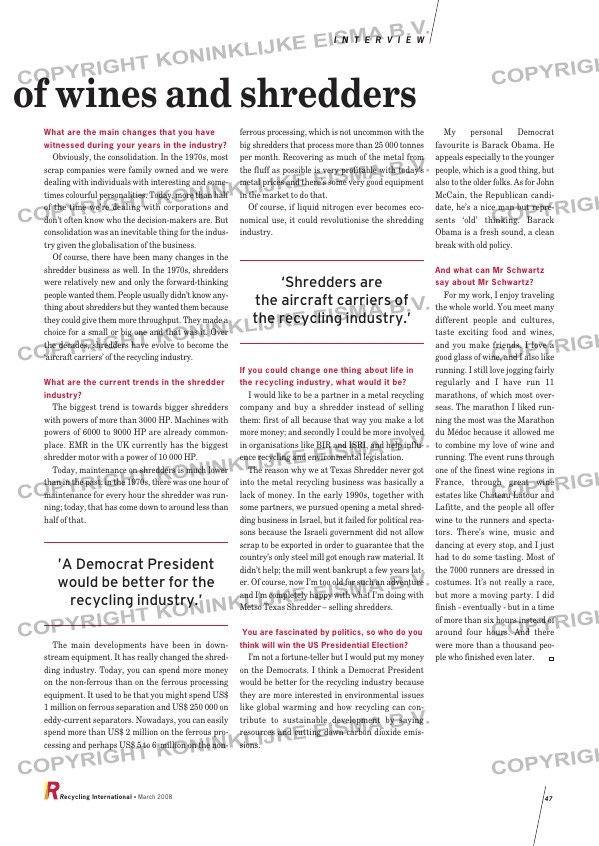Page 47 from: March 2008

What are the main changes that you have
witnessed during your years in the industry?
Obviously, the consolidation. In the 1970s, most
scrap companies were family owned and we were
dealing with individuals with interesting and some-
times colourful personalities. Today, more than half
of the time we’re dealing with corporations and
don’t often know who the decision-makers are. But
consolidation was an inevitable thing for the indus-
try given the globalisation of the business.
Of course, there have been many changes in the
shredder business as well. In the 1970s, shredders
were relatively new and only the forward-thinking
people wanted them. People usually didn’t know any-
thing about shredders but they wanted them because
they could give them more throughput. They made a
choice for a small or big one and that was it. Over
the decades, shredders have evolve to become the
‘aircraft carriers’ of the recycling industry.
What are the current trends in the shredder
industry?
The biggest trend is towards bigger shredders
with powers of more than 3000 HP. Machines with
powers of 6000 to 9000 HP are already common-
place. EMR in the UK currently has the biggest
shredder motor with a power of 10 000 HP.
Today, maintenance on shredders is much lower
than in the past: in the 1970s, there was one hour of
maintenance for every hour the shredder was run-
ning; today, that has come down to around less than
half of that.
The main developments have been in down-
stream equipment. It has really changed the shred-
ding industry. Today, you can spend more money
on the non-ferrous than on the ferrous processing
equipment. It used to be that you might spend US$
1 million on ferrous separation and US$ 250 000 on
eddy-current separators. Nowadays, you can easily
spend more than US$ 2 million on the ferrous pro-
cessing and perhaps US$ 5 to 6 million on the non-
ferrous processing, which is not uncommon with the
big shredders that process more than 25 000 tonnes
per month. Recovering as much of the metal from
the fluff as possible is very profitable with today’s
metal prices and there’s some very good equipment
in the market to do that.
Of course, if liquid nitrogen ever becomes eco-
nomical use, it could revolutionise the shredding
industry.
If you could change one thing about life in
the recycling industry, what would it be?
I would like to be a partner in a metal recycling
company and buy a shredder instead of selling
them: first of all because that way you make a lot
more money; and secondly I could be more involved
in organisations like BIR and ISRI, and help influ-
ence recycling and environmental legislation.
The reason why we at Texas Shredder never got
into the metal recycling business was basically a
lack of money. In the early 1990s, together with
some partners, we pursued opening a metal shred-
ding business in Israel, but it failed for political rea-
sons because the Israeli government did not allow
scrap to be exported in order to guarantee that the
country’s only steel mill got enough raw material. It
didn’t help; the mill went bankrupt a few years lat-
er. Of course, now I’m too old for such an adventure
and I’m completely happy with what I’m doing with
Metso Texas Shredder – selling shredders.
You are fascinated by politics, so who do you
think will win the US Presidential Election?
I’m not a fortune-teller but I would put my money
on the Democrats. I think a Democrat President
would be better for the recycling industry because
they are more interested in environmental issues
like global warming and how recycling can con-
tribute to sustainable development by saving
resources and cutting down carbon dioxide emis-
sions.
My personal Democrat
favourite is Barack Obama. He
appeals especially to the younger
people, which is a good thing, but
also to the older folks. As for John
McCain, the Republican candi-
date, he’s a nice man but repre-
sents ‘old’ thinking. Barack
Obama is a fresh sound, a clean
break with old policy.
And what can Mr Schwartz
say about Mr Schwartz?
For my work, I enjoy traveling
the whole world. You meet many
different people and cultures,
taste exciting food and wines,
and you make friends. I love a
good glass of wine, and I also like
running. I still love jogging fairly
regularly and I have run 11
marathons, of which most over-
seas. The marathon I liked run-
ning the most was the Marathon
du Médoc because it allowed me
to combine my love of wine and
running. The event runs through
one of the finest wine regions in
France, through great wine
estates like Chateau Latour and
Lafitte, and the people all offer
wine to the runners and specta-
tors. There’s wine, music and
dancing at every stop, and I just
had to do some tasting. Most of
the 7000 runners are dressed in
costumes. It’s not really a race,
but more a moving party. I did
finish – eventually – but in a time
of more than six hours instead of
around four hours. And there
were more than a thousand peo-
ple who finished even later.
I N T E R V I E W
r of wines and shredders
’A Democrat President
would be better for the
recycling industry.’
‘Shredders are
the aircraft carriers of
the recycling industry.’
Recycling International • March 2008 47
RI_044 Interview Jim S:Opmaak 1 04-03-2008 11:59 Pagina 47



